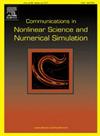Light-powered self-striking liquid crystal elastomer hammers inspired by mantis shrimp
IF 3.4
2区 数学
Q1 MATHEMATICS, APPLIED
Communications in Nonlinear Science and Numerical Simulation
Pub Date : 2025-03-26
DOI:10.1016/j.cnsns.2025.108802
引用次数: 0
Abstract
Self-sustainable systems can absorb energy from steady environment and spontaneously generate continuous motions. Inspired by explosive predation of the mantis shrimp, this paper designs a self-striking hammer using liquid crystal elastomers (LCEs) powered by steady illumination, which consists of an LCE fiber, a rope, a slider, a track, two springs, and a hammer. The mechanical model of the self-striking hammer is first established, and then quasi-static analysis is performed to investigate dynamic behaviors of light-powered self-striking, including alternating snap and snap-back. Meanwhile, the period of the self-striking was analyzed based on photothermally-responsive LCE model. The calculations show that the self-striking originates from the competition between the elastic energies of the LCE and two springs, and the critical conditions for self-striking are mainly influenced by the light-driven contraction of the LCE fiber. Additionally, the period of self-striking is composed of durations of the snap and the snap-back. For given critical light-driven contractions, the duration of the snap depends on the contraction coefficient of the LCE and the light intensity, while the duration of the snap-back remains constant. Compared to traditional self-sustainable systems, the self-striking LCE hammer relies less on rapid-response active materials, releases energy quickly, and features a simple structure, making it promising for applications in rescue operations and military applications.
灵感来自螳螂虾的光能自击液晶弹性体锤
自我可持续系统可以从稳定的环境中吸收能量,并自发地产生连续运动。受螳螂虾爆炸性捕食的启发,本文设计了一种使用液晶弹性体(LCEs)的自击锤,该自击锤由一根LCE纤维、一根绳子、一个滑块、一个轨道、两个弹簧和一个锤组成。首先建立了自击锤的力学模型,然后进行了准静态分析,研究了光动力自击锤的动态特性。同时,基于光热响应LCE模型对自冲击周期进行了分析。计算结果表明,LCE的自撞击是由于LCE和两个弹簧的弹性能之间的竞争引起的,而自撞击的临界条件主要受LCE光纤的光驱动收缩的影响。此外,自击周期由快照和快照恢复的持续时间组成。对于给定的临界光驱动收缩,快速回缩的持续时间取决于LCE的收缩系数和光强,而快速回缩的持续时间保持不变。与传统的自持续系统相比,自冲击LCE锤对快速反应活性材料的依赖较少,释放能量快,结构简单,在救援行动和军事应用中具有广阔的应用前景。
本文章由计算机程序翻译,如有差异,请以英文原文为准。
求助全文
约1分钟内获得全文
求助全文
来源期刊

Communications in Nonlinear Science and Numerical Simulation
MATHEMATICS, APPLIED-MATHEMATICS, INTERDISCIPLINARY APPLICATIONS
CiteScore
6.80
自引率
7.70%
发文量
378
审稿时长
78 days
期刊介绍:
The journal publishes original research findings on experimental observation, mathematical modeling, theoretical analysis and numerical simulation, for more accurate description, better prediction or novel application, of nonlinear phenomena in science and engineering. It offers a venue for researchers to make rapid exchange of ideas and techniques in nonlinear science and complexity.
The submission of manuscripts with cross-disciplinary approaches in nonlinear science and complexity is particularly encouraged.
Topics of interest:
Nonlinear differential or delay equations, Lie group analysis and asymptotic methods, Discontinuous systems, Fractals, Fractional calculus and dynamics, Nonlinear effects in quantum mechanics, Nonlinear stochastic processes, Experimental nonlinear science, Time-series and signal analysis, Computational methods and simulations in nonlinear science and engineering, Control of dynamical systems, Synchronization, Lyapunov analysis, High-dimensional chaos and turbulence, Chaos in Hamiltonian systems, Integrable systems and solitons, Collective behavior in many-body systems, Biological physics and networks, Nonlinear mechanical systems, Complex systems and complexity.
No length limitation for contributions is set, but only concisely written manuscripts are published. Brief papers are published on the basis of Rapid Communications. Discussions of previously published papers are welcome.
 求助内容:
求助内容: 应助结果提醒方式:
应助结果提醒方式:


